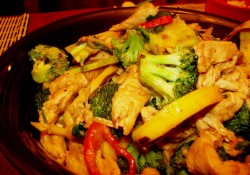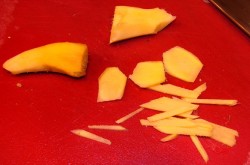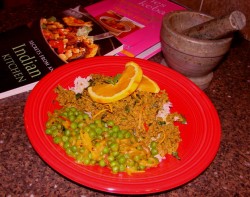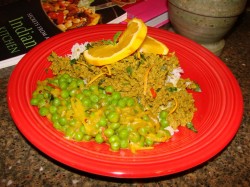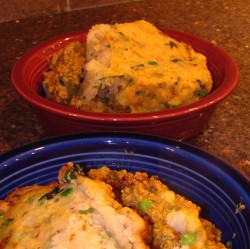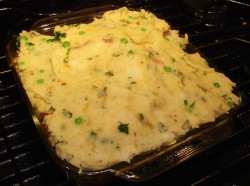Another Simple Stir-Fry: Lemon-Ginger Chicken with Broccoli
Chicken with broccoli is one of those dishes that you will find on every Chinese-American restaurant menu; lemon chicken is another old standard.
However, I have never been partial to any rendition of either of those dishes.
Which is really odd, considering that I like chicken, broccoli and lemons. Chicken was my favorite meat when I was growing up, and I loved broccoli so much, I used to snag bits of it from the garden to eat raw while going about my business of chores and play at my grandparents’ farm every summer. And lemons–well, I used to eat them like oranges until my dentist told me that the citric acid wasn’t good for my tooth enamel. That dulled my enthusiasm somewhat, though I still would drink gallons of very sour lemonade every chance I got.
When it comes to the standard American-Chinese restaurant dishes, however, there was seldom much for me to like. Chicken with broccoli is usually swimming in nondescript brown sauce, while the deep-fried nuggets of battered chicken of lemon chicken were always inundated with a candy-sweet nuclear-yellow glop that bore no resemblence in actual color and flavor to real lemons.
What to do?
Make up my own recipe, of course!
I love broccoli cooked with lemon, so I decided to combine the basics of the two dishes into one recipe. Forgoing thick sauces, I decided to pare the ingredient list down as far as possible. The only Chinese pantry basics I call for in this recipe are light soy sauce, Shao Hsing wine or sherry and sesame oil. These are easily found in most grocery stores, as are the rest of the ingredients: fresh ginger, scallions, lemons, chile peppers, raw or brown sugar, cornstarch, chicken and broccoli.
About the chile peppers: I used red fresno peppers, which are moderately hot. I suggest you use whatever you like, though red peppers look prettiest in this dish, and also allow those who cannot handle a lot of heat to avoid eating them if they wish. Red jalapenos would work just as well, and if you really like heat, red Thai chilies would be great. You can leave the chilies out of this dish, but I find the balance between the heat of the peppers and the sour tang of lemon to be a sparkling complement to the mild chicken and intense green freshness of broccoli. And as usual, the number of peppers and level of heat is totally to your taste. Put in as many or as few as you like. As written, this is a medium-spicy dish.
One could substitute deep fried tofu for the chicken here, but I bet that wheat gluten, also known as seitan would be even better here. It has a wonderfully chewy texture, and it would soak up the flavor of the tangy sauce very well.
Oh, and in order to cut the ginger into fine jullienne, cut the peeled rhizome into thin slices first. Then stacking the slices three high, cut them into thin matchsticks or slivers. It is that simple.
At any rate, on to the recipe:
Lemon-Ginger Chicken and Broccoli
Ingredients:
1 pound boneless skinless chicken breasts or thighs, cut into 1″X!/2″X1/4″ pieces
1 teaspoon light soy sauce
1 tablespoon fresh lemon juice
1 teaspoon brown or raw sugar
1 tablespoon Shao Hsing wine or sherry
2 tablespoons cornstarch
4 tablespoons peanut or canola oil
5 scallions, white and light green parts only cut thinly on the bias
3″ cube fresh ginger, peeled and cut into fine julienne
2 ripe red fresno or jalapeno chile peppers, sliced thinly on the bias
zest of two lemons, in long, thin pieces, and divided into two equal portions (I used a zester, rather than a microplane grater to get these pieces)
2 tablespoons Shao Hsing wine or sherry
1-2 tablespoons light soy sauce
1 pound broccoli, florets broken up into bite sized pieces, with the large stalks peeled and cut into thin slices (If you do not like the stalks don’t use them, but Zak likes them better than the florets, and I think they are delicious, so into the wok they go.)
juice of two lemons
1 lemon washed and cut in half longitudinally, then cut into 1/4″ thick half-moon slices
1/4 teaspoon sesame oil
Method:
Mix chicken with the next five ingredients, and allow to marinate for twenty to forty minutes.
Heat wok over high heat until a thin thread of smoke rises. Add 3 tablespoons peanut or canola oil (reserve last tablespoon until later) and allow to heat another thirty seconds. Add scallions, ginger, chilies and half of the lemon zest and stir fry for thirty to forty seconds, or until all is fragrant.
Add marinated chicken, and spread into a single layer on the bottom of the wok, and leave undisturbed for about one minute, or until the chicken browns on that side. Stir fry until the chicken is 2/3 done–in other words, 2/3 of the chicken is white or brown, and the rest is pink. Add half the lemon slices and stir fry for another thirty seconds, then remove chicken and lemon from wok to a clean bowl.
Add reserved tablespoon of oil to wok, and allow it to heat thirty seconds. Add broccoli and stir fry for thirty seconds, then add wine and lemon juice. Deglaze any browned bits sticking to wok, and add chicken back to wok. Add soy sauce and continue stir frying until chicken is completely cooked. Add other half of lemon zest and slices, and drizzle with sesame oil, and serve over steamed rice.
(This recipe will serve between four to five people, depending on how much rice they eat.)
Local Food in the News: Here, There, and Everywhere
Local food has started to really gain the attention not only of alternative media sources such as bloggers, internet publications and niche print publications, but has been picked up by mainstream print publications like Time Magazine, and has become a topic of conversation in the halls of government around the world.
Readers with long memories may remember that last June, Time Magazine did a small story on local foods called “The Lure of the 100-Mile Diet,” which included quotes from myself and other folks who strive to eat as locally as possible.
Well, this week, the practice of eating locally is not only featured in Time, it is the cover story. John Cloud’s “My Search For The Perfect Apple,”(in the online edition, it is entitled, “Eating Better Than Organic”) leans heavily on the idea that local, fresh food tastes better. This was a concept I pushed in my interview for Time Magazine–that while we may not be able to prove the health benefits of local food, and people may not care enough about the environment to eat locally, I can say without a doubt that once folks get a taste of truly fresh local food, they will not want to eat the pallid imitations at the grocery store again if they can help it.
The author gets stuck on the debate of organic vs. local, which is fine; the conundrum has given many a blogger pause for thought, and he is bringing these thoughts and ideas into the consciousness of the average American grocery shopper,. He notes that because of the climate of New York, it is nearly impossible to grow chemical-free apples, and he is quite correct. Farmers in California can do it because it is fairly dry, but the humidity of the midwest and northeastern US makes it all but impossible to do without some chemical sprays.
And he notes mistrust of these chemicals, which is fine, yet at the end of his article, he adds that he does trust food scientists and processors to make organic versions of processed foods. This sort of ambivalence I think is natural to someone who has really just begin to think about where his food comes from and what that means, and I think that a lot of Time’s readers will be able to relate to his opinions.
Meanwhile, across the Atlantic, in the UK, Conservative Party Leader David Cameron writes an op-ed piece for the Yorkshire Post Today advocating for British farmers and their products. In “We Trust Our Farmers, So Let’s Buy Their Local Food,” Cameron lists economic growth, consumer health, environmental sustainability, animal welfare and food security among shis reason for his strong support of the ideals of local food in the UK.
In order to help consumers who have shown growing interest in native UK products, Cameron calls for stronger “point of origin” label laws in order to ensure that consumers can be certain that they are buying British products. Current laws make informed consumer choices in extremely difficult:
“Take “smoked” bacon, purchased in packaging that states “produced in the UK”. Most people would think that it came from a British pig farm. But, under current legislation, it is possible that the bacon was imported from abroad, and only “smoked” in the UK. This is clearly misleading and unfair to both consumers and our pig farmers.”
Citing the ways in which food strengthens families, communities and culture, he ends his essay with an eloquent statement:
“In the 21st century, people are interested in general well-being. The food they eat and feed their families, the strength of their relationships and local communities and the environment they share and the beauty of their surroundings, are all a vital part of that. In more ways than one, buying local food can be the great sustainer.”
While I believe that eating locally is still only possible for a few (mostly middle to upper class) people in the US and the UK, it is still a viable alternative to the current model of mass agriculture. As the demand for local food grows, more small farmers will find ways to satisfy that opening market and prices will begin to lower, making locally produced food more affordable to everyone. State and federal programs such as WIC can issue coupons that are accepted at local farmer’s markets (we have a program for that in Ohio, and it is commonly used here in Athens), allowing people on lower incomes to benefit from the freshness of local foods while supporting the local economy.
We can probably never feed everyone in the entire world locally, but what we can do is feed -more- people locally than we do now. By doing this we are not only sustaining the livelihoods of small farmers around the world, but also providing fresher, tastier and environmentally sound food for more of the citizens of the world.
That is a goal that I look forward to seeing achieved.
From Hyderabad: Narangi Keema
I love to try new recipes, especially if they are unusual or rare in some way.
When I first picked up and reviewed Madhur Jaffrey’s book From Curries to Kebabs, one of the recipes I singled out to try in the future was a keema (minced meat) recipe that included orange zest and juice as a flavoring.
Never before had I heard of this recipe in all of my cookbooks and research had I heard of this dish.
Jaffrey notes that she had only heard of the recipe once, from the sister of a film director with whom she was working. The woman, at her request, scribbled this most unusual dish, from Hyderabad, onto a piece of paper, and Jaffrey said that fifteen years later, she still had it, and it creates a meal just as fragrant and delicious as one could imagine.
The origin for the dish as told by Jaffery is that it dates back to the Moghul Empire when governors were appointed to administer the far away southern provinces. There was a court in Hyderabad, where northern cooks practiced the royal Moghul style of cuisine which gradually became blended with the spices, techniques and ingredients typical of southern India. In this time, the rulers of Hyderabad apparently favored Persian and Turkish women for their brides, and with these women’s personal retinues came cooks who brought the tradition of flavoring meats with oranges and orange zest.
Among all of the other recipes I had marked to try from this book, Narangi Keema was temporarily forgotten, until I picked up a cookbook from the noted UK Indian author Mridula Baljekar, Secrets from an Indian Kitchen.
I was surprised and thrilled to see that she, too, had a recipe for Narangi Keema, and that hers was slightly different from Jaffery’s.
I decided to synthesize the two recipes and make my own using what I had in my kitchen and taking advantage of the current crop of seasonal oranges.
The main differences were in the spices, how the orange zest was treated, how much orange juice was used and in the use of dairy products.
Jaffrey’s recipe called for an elaborate preparation of the orange rind using boiling water and turmeric, presumably to both color the rind and remove any residual bitterness from the white part of the pith, while Baljekar simply has the cook put the grated zest into the dish near the end of cooking, along with the orange juice. Jaffrey’s recipe also included five tablespoons of yogurt cooked with the meat, presumably to tenderize it.
For myself, instead of using yogurt, which I did not have, I cooked the meat in a small amount of milk. This is a technique I learned from an Italian chef in culinary school which I use in cooking all ground and minced meats, except for the stir-fried ones. This technique results in very tender, non-clumped, almost silky ground meats, which are full of flavor.
I preferred Baljekar’s spicing; she included cardamom, cloves and cinnamon, all of which seemed as if they would enhance the citrus fragrance from the orange zest. Both authors called for the use of ginger, but only Baljekar called for garlic. Since I was working with lamb, I decided to use the garlic–to me, lamb without garlic is fairly unnatural.
Both authors called for the use of fresh herbs, so just before serving, I also stirred in a handful of roughly chopped cilantro and mint leaves, which gave yet another layer of flavor to the dish. At the same time, fresh green chile slices are stirred in to add sparkles of fire to the keema. If pomegranate seeds had still been in season, I would have used a handful of them as well, not only because they are pretty, but because the flavor of them would complement the spices and orange zest beautifully.
The end result is a fresh, lightly flavored, very delicate keema. We ate ours over rice, but I am thinking that using orange halves that have had the flesh scraped out as cups would be a pretty presentation for next time. I think it would also be interesting to use this keema to stuff mushrooms or eggplant, though instead of orange, I think lemon or lime zest and juice would be even better for that purpose.
At any rate, here is the recipe–I hope you enjoy it.
Naranji Keema
Ingredients:
3 tablespoons canola oil
1 medium yellow onion, peeled and thinly sliced
1 2″ stick cinnamon
4 green cardamom pods
4 cloves
1 inch cube of ginger root, peeled and grated
3 cloves garlic peeled and crushed
1 teaspoon cumin seeds
1 tablespoon coriander seeds
1/2 teaspoon ground turmeric
1/2 teaspoon ground cayenne pepper (optional)
1 pound ground lamb
1/2 cup milk
1 cup freshly squeezed orange juice
zest of two oranges, finely grated
salt to taste
1/2 cup packed fresh cilantro leaves, roughly chopped
2 tablespoons fresh mint leaves, chopped
2-3 green chilies (I used cayenne) thinly sliced (optional)
1-2 tablespoons orange zest in thin strips for garnish
Method:
Heat oil in a heavy bottomed skillet. Add onion, and cook, stirring, over medium heat. Add the cinnamon stick when the onions just begin to take on a pale gold color and cook, stirring, until the onion is a dark golden brown, and the cinnamon is fragrant.
While the onion is cooking, grind together all of the remaining spices (from the cirdamom pods to cayenne pepper) into a thick paste. When the onion is a dark golden brown, add the spice paste, and cook stirring, for about two or three minutes. Add the lamb and the milk, and stir together, breaking up the lamb. Keep stirring until the lamb is browned, and allow most of the milk to boil away.
Add about 1/4 cup of water, turn the heat down to low and allow the lamb to continue cooking until it is mostly dried out. Add the orange juice and zest, and allow to cook until it is nearly dried out again. Taste, and add salt as needed.
Stir in the fresh herbs and the chilies, and allow to cook for one more minute, just until the herb leaves wilt and the chilies have a chance to release their oils slightly.
Serve over rice pillau or plain steamed basmati rice garnish with thin ribbons of orange zest.
An English Casserole Kissed By Indian Spices
I try to love casseroles, and I do. At least, in theory, I do.
What is not to love? They are nice, warm dishes that are baked in a nice hot oven where they are transformed into cozy, homey and comfort food, that often involves bubbling melted cheese with luscious browned crispy bits on top.
Well, in theory, all of that is true. But, having grown up in the era of bland casseroles composed of a can of soup stirred into a can of gloop with a can of crunchy bits and shredded processed cheese sprinkled on top, I have to admit to being somewhat leery of casserole recipes. I will give them a wide berth out of fear that they will turn out to be tasteless gooey messes that even melted and browned sharp cheddar cheese cannot save.
However, I -do- make some casseroles myself, which I go out of my way to ensure that they never see a soup can and are never bland. Enchiladas, moussaka, lasagne, baked macaroni and cheese, and of course, the classic, if ugly, shepherd’s pie have all graced my oven from time to time. All of them are excellent in large part because I start from fresh ingredients and eschew cans altogether, with the exception of using canned tomatoes for sauces when I am not cooking in the summer.
The last time I made shepherd’s pie, however, as I was making the meat filling which at my house consists of ground lamb, herbs, onions or leeks, garlic, mushrooms, carrots, turnips and corn cooked with a bit of broth that is later thickened into a gravy, I realized how similar the cooking process was to the making of keema sookh–a quick weekday curry consisting of ground lamb cooked with onions, garlic, ginger, chilies, spices and vegetables until a rather dry dish is made to serve over rice. Thinking that, I wondered how it would taste if I put keema sookh into a casserole dish and covered it with a layer of mashed potatoes and cooked it like shepherd’s pie.
Then, as I was mashing the potatoes, I decided that if I were to use keema sookh as a filling for shepherd’s pie, I should also “Indianize” the potatoes as well. Thinking on one of my favorite Indian appetizers, potato and pea-filled samosas, I had a thought. Why not cook up samosa filling, and turn it into mashed potatoes and use that for the topping?
So, that is how I made my Anglo-Indian fusion shepherd’s pie last week. I did alter my keema sookh recipe a bit in order to make it wetter–so that there would be a curried gravy. I left some of the water in with the keema, and thickened it; however, instead of using flour or roux as I usually do for shepherd’s pie, I used a couple of tablespoons of Indira’s Magic Powder. This powder of ground roasted, hulled chickpeas and spices not only thickened the gravy, but added a wonderful texture and flavor to the keema filling.
How did it all turn out?
Not only was it as comforting and filling as shepherd’s pie always is, but it was also fragrant with spices and herbs, with the popping sweetness of peas in the mostly mashed potato topping. Even Zak, who was skeptical of the entire experiment, was converted in the end to loving the newly remade casserole, so I think this will appear on our table again and again when the cold winds of winter blow.
Ingredients for Filling:
4 cloves garlic
1 1″ cube fresh ginger
2 fresh thai chile peppers, stemmed (optional)
2 tablespoons cumin seeds
2 1/2 tablespoons coriander seeds
1/4 teaspoon cardamom seeds
1 teaspoon black peppercorns
1/2 teaspoon red pepper flakes
1 medium onion, sliced as thinly as possible
1 teaspoon salt
2-3 tablespoons vegetable oil or ghee
1 pound ground lamb, goat or beef
1/2 cup milk
2 tablespoons sweet paprika
2 tablespoons turmeric
water as needed
1 cup fresh green beans, stringed and snapped into 1″ pieces
2 tablespoons dalia powder
salt to taste
1/2 cup fresh mint leaves, lightly chopped
Ingredients for the Potato Topping:
1-1/4 lb. baking potatoes peeled and diced
8 large cloves garlic
1/4 cup ghee or butter
1 tsp. coriander seeds, ground
1 teaspoon cumin seeds, divided–1/2 ground, the other, whole
1 medium onion, thinly sliced
1-2 fresh thai chilies, sliced thinly (optional)
1 tsp. freshly grated ginger
1/4 cup milk or yogurt
1/4 cup fresh cilantro, roughly chopped
1/2 cup frozen green peas, thawed
1 tsp. garam masala
salt to taste
Method:
Preheat oven to 375 degrees, F.
For the filling, grind the dry and wet spices (the first 8 ingredients) into a paste.
Heat a heavy skillet over medium heat, add oil or ghee. As soon as oil is hot, add the onions, and cook, stirring, until they are a very dark reddish brown. When they are about halfway cooked (golden brown) add salt and keep cooking. This helps force out as much juice as possible, which hastens the browning process.
Once the onions are brown, add the ground spices together and cook in the oil for about a minute. Add the ground meat and the milk, and begin chopping the meat into the milk until it all begins to fall apart and brown. Add the paprika and turmeric, and cook down until the milk is evaporated. At this point, add water, and continue cooking for twenty minutes, adding water as needed to keep it from boiling completely away.
After twenty minutes of simmering, add the green beans and about 1/2 cup of water and cook until the green beans are barely tender and the water is nearly cooked away. Add salt to taste, and the dalia powder, and stir until the liquid is thickened into a gravy. Stir in fresh mint, and remove from the heat. Spray a 9″X9″ casserole pan with vegetable oil, and scrape filling into the pan, and set aside.
For the topping, boil the potatoes and garlic together in salted water until the potatoes are just starting to fall apart, drain.
While the potatoes are cooking, melt butter or ghee in a frying pan, then add the onions, and fry, stirring until they are golden brown. Add the spices, ground and whole, the chile and the ginger and fry, stirring until the onions are reddish brown.
Set aside 1/4 of the potatoes, and mash the rest with the garlic. Add the milk or yogurt, and beat until smooth. Stir in the onions, spices and butter or ghee, the cilantro, the peas, the set-aside potatoes, and garam masala. Add salt to taste. Spread potato mixture over the keema filling, and bake for 25-30 minutes until hot, with a bubbly filling and browned spots on the potatoes.
My Favorite Chinese Cookbooks For Beginners–In No Particular Order
People often ask me what my favorite Chinese cookbook is, and I never can give a simple answer. For one thing, I collect them, and have well over a hundred different titles at this point, some of them brand new, in-print books, and others out of print, some of them even vanishingly rare.
For another thing, I like different books for different reasons. Some books are excellent teaching manuals; they give the beginner excellent instruction in the fundamentals of the art of Chinese cookery. Other volumes teach one aspect of Chinese cookery, such as dim sum, and do it well. Some are great generalized cookbooks, while others focus on a particular single regional cuisine. Some contain clear photographs illustrating techniques and ingredients, others have beautiful scenic photographs, while others are not illustrated at all.
One commonality to all of the cookbooks I favor, Chinese or otherwise, is that they give a great deal of cultural information.
Every recipe has a story, and my very favorite cookbooks are written by authors who are not only excellent cooks and teachers, but also accomplished storytellers. That is why nearly every book on this list, with a few exceptions, are not only good cookbooks for those setting out to learn Chinese cuisine, but also darned good reads for anyone interested in the culinary arts in general. Without further ado, here are some of my favorite Chinese cookbooks meant to instruct beginners, in no particular order, which I think will be helpful and entertaining to beginning and intermediate cooks.
The Key to Chinese Cooking by Irene Kuo: This excellent comprehensive cookbook is unfortunately out of print; however, used copies are easily found at good prices via Bookfinder, Amazon, or eBay. Kuo’s precise prose carefully explains the techniques of Chinese cookery in an easily understandable step-by-step format that is illustrated with clear line drawings. Comparable in scope and detail to Julia Child and Simca Beck’s Mastering the Art of French Cooking,, this text is very strong on learning technique, particularly proper cutting and ingredient preparation. With over three hundred recipes (for both simple and complex dishes), many of them requiring simple ingredients, this gem is a perfect introduction to Chinese cooking, even for cooks who have limited access to an Asian market. Each recipe is clearly written and includes relevant cultural and historical information, as well as thorough background on ingredients and successful substitutions.
The Modern Art of Chinese Cooking by Barbara Tropp: Another great introduction to the Chinese kitchen, The Modern Art of Chinese Cooking stands as an enduring legacy of the late writer, chef and restaurateur, Barbara Tropp. Not only was Tropp a great chef and teacher, she also told great stories of her experiences in China, many of which were humorous or poignant. In addition, her clear instructions delineate the hows and whys of Chinese cookery, while presenting recipes which are not only authentic in flavor, but are still quite accessible to Western palates. Some readers may criticize her instructions and methodology for being long-winded and needlessly wordy, but I disagree. Her explanations of technique are not wordy, but -complete- with the sort of clear writing necessary to explain complex series of tasks to rank beginners. Anything less thorough runs the risk of losing new cooks. My one quibble with this book is that it lacks sufficient photographic or line-drawing illustrations. Many people learn visually, and I have found in my years of teaching that some students can read a passage of text one hundred times and still have trouble folding a wonton or cutting grass-like slivers of ginger, but when I show them how just once, they understand it completely, and can take their first steps in replicating the action immediately.
Yan-Kit’s Classic Chinese Cookbook by Yan-Kit So: For those who learn visually, this heavily-photograph laden cookbook is the answer to a prayer. Every technique outlined in this book by Yan-Kit So’s simple, elegant prose, is illustrated by clear, close-up color photographs. Most recipes are similarly illustrated, though not all of them, and every unusual ingredient, particularly the fresh and dried condiments and vegetables, are also photographed. However, this is not just a photographic reference book; it is also a very well-written overview of modern Chinese regional cookery that includes recipes famed in China and abroad. An extremely useful book, this one is destined to be well-thumbed and bespattered with soy sauce and various other condiments from becoming indispensable in the kitchen.
The Breath of a Wok by Grace Young: Some may think this is an odd choice for a beginner’s Chinese cookbook, and in some ways it is. However, I think it is very useful for a student to understand the history and the culture surrounding a cuisine at the same time as they learn the more practical aspects of it. In this light, The Breath of a Wok makes much more sense; it is both a personal and historical view of the culture surrounding the development and use of woks in Chinese cookery. The recipes included in the book are an eclectic mixture of homestyle cooking and restaurant fare, with examples of traditional interpretations and modern innovations. In a sense, this very stunningly illustrated book is a testament to the enduringly ancient, yet flexible nature of Chinese cookery, both in its homeland and around the world. In addition to narrative about the wok in history, there is extensive information on how to find and buy one in the here and now, as well as instructions on how to cook in one on a modern American stove to most effectively attain wok hay–the elusive fragrance that comes from high heat and oil-seasoned metal.
The Chinese Kitchen by Deh-Ta Hsiung: This book is less of a cookbook, and more of a reference work on the ingredients common to the kitchens of China. Liberally illustrated with clear photographs, Hsiung’s text is encyclopedic in scope and very easily read and used by a beginner. Filled with cultural information, cooking tips and with recipes for each ingredient entry, The Chinese Kitchen gives the beginner a verbal and visual reference point to many of the unfamiliar staples, foods, condiments and packaged goods at the neighborhood Asian market. The descriptions are written so as to give plenty for the curious beginner or intermediate cook to chew on without being overwhelmingly technical, and the photographs, whether of the ingredients themselves, of finished dishes or of Chinese open air markets, are enlightening and inspiring. I cannot recommend this book enough–it is one that I return to often as a cook, a writer and a teacher.
There we have it–my favorite Chinese cookbooks for beginners. Look for further entries in the future on the subjects of Chinese cookbooks for advanced cooks, for instruction on regional cookery and cookbooks on specialized topics.
Until then, happy reading, cooking and eating!
Powered by WordPress. Graphics by Zak Kramer.
Design update by Daniel Trout.
Entries and comments feeds.

